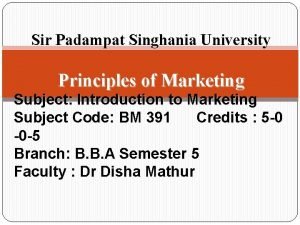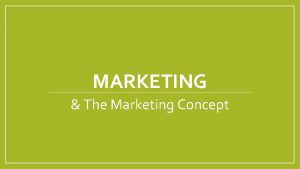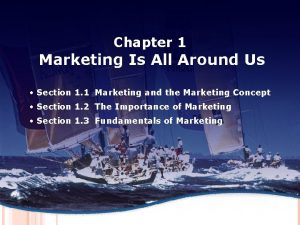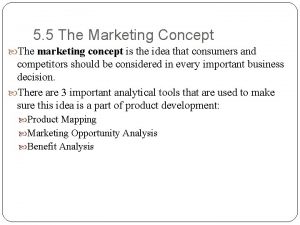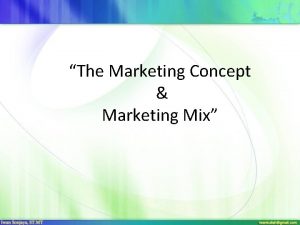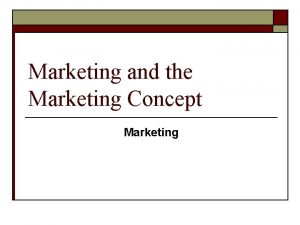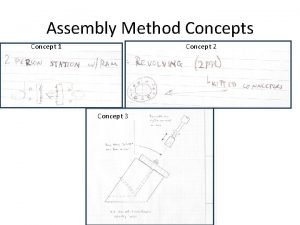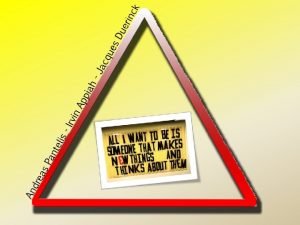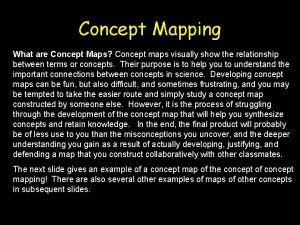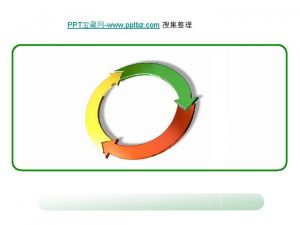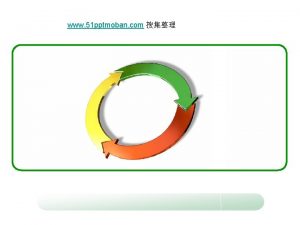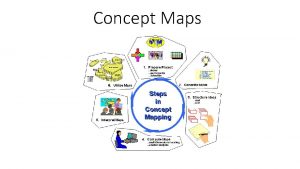Chapter 20 Marketing MARKETING CONCEPT The marketing concept












































- Slides: 44

Chapter 20: Marketing

MARKETING CONCEPT • The marketing concept ensures that the business always focuses on the needs of consumers first, before it develops a good or service.

MARKETING • Marketing is the business processes that are used to understand, anticipate and satisfy consumer needs and wants both now and in the future. • Marketing requires the business to: 1. Conduct market research 2. Develop a marketing strategy and marketing plan 3. Formulate the marketing mix.

MARKETING STRATEGY AND MARKETING PLAN Marketing Strategy Marketing Plan • The strategy examines the overall business objectives and develops marketing activities to help the business to achieve these goals. • The marketing plan is used to implement the firm’s marketing strategy.

Marketing Plan Conduct a SWOT Analysis → Identify its internal strengths and weaknesses and examine its external threats and opportunities. Market Segmentation → Decide on a market at which it will target its product. Research the Target Market → Find out the needs and wants of consumers in this market. Develop a Marketing Mix → This will ensure that it uses the most appropriate product, price, place and promotion to persuade consumers to buy the product.

Role of the Marketing Plan in a Business Goals • The marketing plan helps the business to focus on achieving its goals. This can mean that the business achieves these goals more effectively and efficiently. Finance • The marketing plan shows potential investors that the business has conducted an in-depth analysis of the market. Benchmarking • The business can use the marketing plan to benchmark planned performance against actual results.

MARKETING SEGMENTATION The market is divided into different sections (segments). Geographic Demographic Psychographic • The market is divided into different geographic zones/areas. • The market is divided based on certain common characteristics. • The market is divided based on beliefs, attitudes, social status and lifestyle.

Benefits of Market Segmentation Increased Sales →It provides a product that meets the needs of the target market. This can increase consumer loyalty and boost a firm’s sales and profits. Market Share →Market segmentation enables the firm to focus on a small section of the market and allows the business to grow over time. Lower Costs →The business does not waste time and money trying to sell to different target markets. This helps to reduce the firm’s marketing costs.

TARGET MARKET • A target market is the specific group of consumers who have common needs and wants. The business aims its products and services at this market.

Niche Market Advantages 1 Less Competition There is less competition in a niche market, as other businesses focus on the larger general target market. 2 Consumer Loyalty Consumers are loyal to the goods and services that satisfy their specific needs in a niche market. This can help to increase business sales and profits. 3 New Products A business selling in a niche market may be able to launch new products into the market more easily. Consumers trust the brand are willing to try new products from the firm.

Niche Market Disadvantages 1 Economies of Scale The business might not benefit from economies of scale as it produces goods in smaller quantities. 2 Competition Larger competitors enter the market and the smaller business may be unable to compete on price. It may lose market share to the larger firm. 3 Growth As niche markets tend to be small, the business may find it difficult to grow. Profit margins are also lower in smaller markets.

PRODUCT POSITIONING • Creating a positive image for the product that stays in consumers’ minds.

MARKETING MIX 1. Product 2. Price 3. Place 4. Promotion

1. Marketing Mix – Product • This is a good or service provided by a business to satisfy consumer needs and wants.

1. Marketing Mix – Product A. Product design B. Brand name C. Packaging D. Product life cycle

A. Product design When designing a product, a business should carefully consider the:

B. Brand Name • A distinctive name given to a business and the goods and services it develops. • Many firms also develop a brand logo: images, words or shapes used to identify a brand its goods and services.

B. Brand Name Advantages for Business Advantages for Consumers Recognition Consumer image New products Benefits of the product Higher Price Reduces disappointment Consumer loyalty High-quality products

Own-Brand Products • These are products that are sold by retailers under the retailer’s name and logo. They are often referred to as ‘ private labels’. Supermarkets such as Tesco and Super. Valu have their own branded products.

Own-Brand Products Advantages for Retailers Disadvantages for Retailers Product Specification Increased Advertising Profits Business Reputation Consumer Loyalty Cost Different Target Markets Economic Conditions

C. Packaging Product protection Image Convenience Information Recognition

D. Product Life Cycle • The product life cycle describes the stages that a product goes through from introduction to decline.

D. Product Life Cycle 1. Introduction • Sales are low as the product is launched on the market. 2. Growth • Sales increase and the business invests in production to keep up with consumer demand. 3. Maturity • Sales and profits reach their peak and the business will have a positive cash flow. 4. Saturation • Sales and cash flow begin to slow down as consumers have purchased the product from the business or competitors. 5. Decline • Sales and profits decline and the business must decide whether it will continue to sell the product or retire it.

D. Product Life Cycle

2. Marketing Mix – Price • Price relates to the amount of money consumers pay for the product offered by a business.

2. Marketing Mix – Price High Price Strategies Low Other

Low Price Strategies Penetration pricing • The business sets a price lower than that of its competitors’ products in order to gain a greater share of the market quickly. Predatory pricing • A business sets a price lower than that of its competitors’ products to push them out of the market. Loss leader • The business sells a product below cost price in the hope that customers will buy other products while visiting their shop.

Higher Price Strategies Premium pricing This gives consumers the impression that the product is of a superior quality. Price skimming A price is charged when the product is launched so that the business can recover R&D costs quickly before competitors enter the market.

Other Price Strategies Psychological pricing • This strategy is based on theory that certain prices have a bigger psychological impact on consumers. Mark-up pricing • The business adds a profit percentage to the cost price of the item, e. g. 10% Tiered pricing • Consumers choose the price level that fits their budget.

Other Price Strategies Price discrimination Bundle pricing • Different segments of the market are charged different prices for the same product. • The business sells multiple items together for a lower price than they would cost separately.

3. Marketing Mix – Place • Place refers to where consumers can buy goods and services sold by the business. To reach the largest possible number of consumers, the business must choose the most appropriate channel of distribution.

Factors Affecting the Channel of Distribution Factor Reason Cost The producer should choose the cheapest but most effective channel of distribution. This increases the profits earned by the producer. Nature of the Product If the product is perishable or has a short shelf life, it is important to use a channel of distribution that gets the product to the consumer as quickly as possible. Target Market The business should choose a channel of distribution that reaches the largest possible target market. Business Image To maintain a brand image, a producer may need to choose a particular channel of distribution. Market Size Wholesalers may store the producer’s products and transport them to retailers. This may be the most financially viable option for a producer to distribute their products to a wide range of consumers.

4. Marketing Mix – Promotional Mix 1. Advertising 2. Sales promotion 3. Public relations 4. Personal selling • Promotion is used to increase consumer awareness of the brand the goods and services that it sells. It uses techniques to persuade consumers to buy the firm’s products over those of competitors.

1. Advertising • Advertising communicates information about a firm’s goods and services to consumers. • It aims to Remind, Inform and Persuade people about a brand its products. • Types of advertising include: 1. Informative 2. Reminder 3. Persuasive 4. Generic 5. Comparative

Advertising Media Television Radio Newspapers Social Media Business Website

Choosing an Advertising Medium Cost • Businesses should use their advertising budget wisely to have the greatest impact on consumers and ensure they get value for money. Type of product/service • The method chosen should reflect the image of the product. Target market • The business should use a method that reaches the largest possible target market. Stage of the product life cycle • Intense advertising may be needed in the launch stage of the product life cycle

2. Sales Promotion • Short-term gimmicks used by businesses to attract consumers to buy products and services.

3. Public Relations (PR) • A marketing technique used to create a positive public image for a business and the products or services it sells.

4. Personal Selling • Sales staff meet consumers face to face, provide information on products and persuade the consumer to purchase them.

PROTECTING CONSUMERS • Consumers can make a complaint about misleading advertising to the following bodies: 1. Competition and Consumer Protection Commission (CCPC) 2. Advertising Standards Authority for Ireland (ASAI)

EVALUATION OF THE MARKETING MIX

Key Terms • • • • marketing concept marketing strategy marketing plan market segmentation geographic segmentation demographic segmentation psychographic segmentation target market niche market product positioning marketing mix product portfolio • • • • patent brand name brand logo brand slogan trademark own-brand products packaging product life cycle pricing strategies penetration pricing predatory pricing loss leader premium pricing

Key Terms • • • • price skimming psychological pricing tiered pricing price discrimination bundle pricing place channel of distribution wholesaler retailer agent promotional mix advertising • • • informative advertising reminder advertising persuasive advertising generic advertising comparative advertising sales promotion merchandising public relations sponsorship endorsements personal selling Advertising Standards Authority for Ireland (ASAI)

CREDIT SLIDE • • Shutterstock i. Stockphotos. com Alamy. com Bord Bia
 Pengertian pemasaran
Pengertian pemasaran Hình ảnh bộ gõ cơ thể búng tay
Hình ảnh bộ gõ cơ thể búng tay Lp html
Lp html Bổ thể
Bổ thể Tỉ lệ cơ thể trẻ em
Tỉ lệ cơ thể trẻ em Chó sói
Chó sói Tư thế worm breton là gì
Tư thế worm breton là gì Bài hát chúa yêu trần thế alleluia
Bài hát chúa yêu trần thế alleluia Kể tên các môn thể thao
Kể tên các môn thể thao Thế nào là hệ số cao nhất
Thế nào là hệ số cao nhất Các châu lục và đại dương trên thế giới
Các châu lục và đại dương trên thế giới Công thức tiính động năng
Công thức tiính động năng Trời xanh đây là của chúng ta thể thơ
Trời xanh đây là của chúng ta thể thơ Mật thư anh em như thể tay chân
Mật thư anh em như thể tay chân 101012 bằng
101012 bằng độ dài liên kết
độ dài liên kết Các châu lục và đại dương trên thế giới
Các châu lục và đại dương trên thế giới Thể thơ truyền thống
Thể thơ truyền thống Quá trình desamine hóa có thể tạo ra
Quá trình desamine hóa có thể tạo ra Một số thể thơ truyền thống
Một số thể thơ truyền thống Bàn tay mà dây bẩn
Bàn tay mà dây bẩn Vẽ hình chiếu vuông góc của vật thể sau
Vẽ hình chiếu vuông góc của vật thể sau Biện pháp chống mỏi cơ
Biện pháp chống mỏi cơ đặc điểm cơ thể của người tối cổ
đặc điểm cơ thể của người tối cổ Thế nào là giọng cùng tên?
Thế nào là giọng cùng tên? Vẽ hình chiếu đứng bằng cạnh của vật thể
Vẽ hình chiếu đứng bằng cạnh của vật thể Phối cảnh
Phối cảnh Thẻ vin
Thẻ vin đại từ thay thế
đại từ thay thế điện thế nghỉ
điện thế nghỉ Tư thế ngồi viết
Tư thế ngồi viết Diễn thế sinh thái là
Diễn thế sinh thái là Dạng đột biến một nhiễm là
Dạng đột biến một nhiễm là Bảng số nguyên tố lớn hơn 1000
Bảng số nguyên tố lớn hơn 1000 Tư thế ngồi viết
Tư thế ngồi viết Lời thề hippocrates
Lời thề hippocrates Thiếu nhi thế giới liên hoan
Thiếu nhi thế giới liên hoan ưu thế lai là gì
ưu thế lai là gì Khi nào hổ con có thể sống độc lập
Khi nào hổ con có thể sống độc lập Sự nuôi và dạy con của hươu
Sự nuôi và dạy con của hươu Sơ đồ cơ thể người
Sơ đồ cơ thể người Từ ngữ thể hiện lòng nhân hậu
Từ ngữ thể hiện lòng nhân hậu Thế nào là mạng điện lắp đặt kiểu nổi
Thế nào là mạng điện lắp đặt kiểu nổi What are the example of ideal self
What are the example of ideal self Three considerations of societal marketing concept
Three considerations of societal marketing concept












































